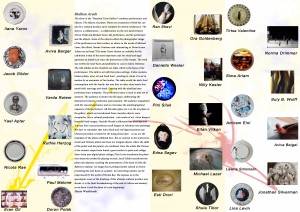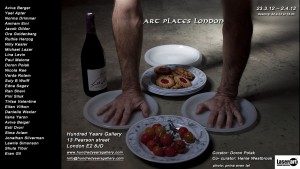

Shulhan Aruch
The show in the “Hundred Years Gallery” combines performance and objects. The objects are plates. Plates are receptacles of food but can also be a cultural product and a template for artistic exuberance. The show is a collaboration – a collaboration on the one hand between Doron Polak and Michael Lazar, the performers, and the performers and the objects. Some of the objects reflect the photographic image of the performers on their surface, as shown in the works of Michael Lazar, Ran Shevi, Norma Drimmer and culminating in Doron’s own “plates on my head.”
The name I have chosen as a subtitle for the exhibition is that of the most important code for ritual and legal questions in Jewish Law since the destruction of the temple. The work was written by Josef Karo and published in 1563 in Safed, Palestine.
The title alludes to the ritualistic set table, which is the focus of the performance. The table is set with four place settings. It also contains broken plates, wine, oil and fresh food – pointing to ritual; it is set in motion by an encounter of two bodies. The table recalls the daily food consumption with the family, but may hint at other ritual meals that mark birth, marriage and death. Feasting with the dead has been performed since antiquity. The performers enact a ritual or play out of memory. The audience is drawn into the space, obliterating the distinction between production and reception. The audience empathizes with the visceral experience and so overcomes the autobiographical exposure of the performers.
All this takes place vis a vis the art plates in the gallery, which are transformed from everyday objects, mere receptacles, into a cultural production – into works of art.
Aviva Berger’s beautiful body images, Daniella Wexler’s silhouette line drawings and Amiram Eini’s sexual positions recall images on Athenian vase paintings. We have to remember that Attic black-and-red-figured pottery and Chinese porcelain, invented in the Song period (960 – 1279), are the templates of the plates exhibited here. But in contrast to the works here, Greek and Chinese plates and vases are integral objects, where the skills of the potter and the painter are combined. Here the artists like Picasso in his ceramic output have found a great surface to paint and collage. Sima Arian uses digital photo collage; Dina Levin transforms the plates into memories evoked by playing records. Jacob Gildor transforms the plates into platters, recalling the presentation of the head of John the Baptist to Salome. An image that is perhaps faintly echoed in Doron presenting his own head on a platter. An interesting rupture can be experienced by the works of Nicola Rae. She exposes us to the apocalyptic noise of the breaking of this ultimate cultural product into shards. Is it the faint foreshadowing of the end of culture and memory as we know it and the dawn of a new beginning?
Henie Westbrook



